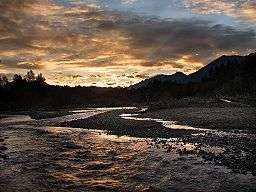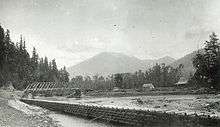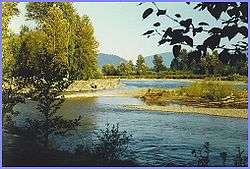Vedder River
| Vedder River | |
| Chilliwack River | |
 The Vedder River, in Chilliwack, BC. | |
| Countries | Canada, United States |
|---|---|
| Province | British Columbia |
| State | Washington |
| Source | Hannegan Pass |
| - coordinates | 48°53′3″N 121°31′42″W / 48.88417°N 121.52833°W [1] |
| Mouth | Sumas River |
| - coordinates | 49°08′N 122°06′W / 49.133°N 122.100°WCoordinates: 49°08′N 122°06′W / 49.133°N 122.100°W [2] |
| Length | 80 km (50 mi) [1] |
| Basin | 1,230 km2 (475 sq mi) [3] |
| Discharge | |
| - average | 77 m3/s (2,719 cu ft/s) |
| - max | 1,150 m3/s (40,612 cu ft/s) |
| - min | 15 m3/s (530 cu ft/s) |
The Vedder River, called the Chilliwack River above Vedder Crossing, is a river in the Canadian province of British Columbia and the U.S. state of Washington.
The name Chilliwack comes from the Halkomelem word Tcil'Qe'uk, meaning "valley of many streams".[4]
Course
Originating as the Chilliwack River in Washington's North Cascades National Park, the river begins at Hannegan Pass and flows north across the Canada–United States border and into Chilliwack Lake. The river flows through Hells Gorge, a deep, dangerous-to-access gorge just below the river's headwaters that is home of a waterfall that the river drops over.[5] The river picks up the Little Chilliwack River before crossing the border. There is a large sandy beach located where the river enters the lake, a popular place for people to party at. The river exits the north end of the lake and flows generally west via the Chilliwack River Valley to emerge on the Fraser Lowland on the south side of the City of Chilliwack. At Vedder Crossing, the river is joined by the Sweltzer River before flowing under a bridge at which its name changes to the Vedder River, after which is flows west and north to join the Sumas River just before that river's confluence with the Fraser River at the northeast end of Sumas Mountain.[2][4] The river crosses the Fraser floodplain from Vedder Crossing to its confluence with the Sumas via the Vedder Canal, which prevents the river's considerable spring freshet from flooding the surrounding farmlands and towns, and which is part of the drainage system that turned Sumas Lake into Sumas Prairie.
Downstream from the Vedder Crossing Bridge, the Vedder River marks the boundary between Yarrow to the south and Greendale to the north (both are separate semi-rural communities that are now part of the City of Chilliwack).
History

Historically the Chilliwack River flowed north from Vedder Crossing, over a broad alluvial fan to the Fraser River. In 1875 heavy rains caused a logjam that diverted the river into two small streams, called Vedder Creek and Luckakuk Creek. This caused hardship for the area's farmers. In 1882 a new logjam was deliberately created which caused the waters of several streams to shift course toward the west, flowing into the now-drained Sumas Lake. A freshet in 1894 caused the new course to become permanent.[6] In the early 20th century the diverted river was diked and channelized. Today the Chilliwack River changes into the Vedder River at Vedder Crossing, and then becomes the Vedder Canal farther downstream.[7] The Vedder Canal was created in the 1920s as part of the effort to drain Sumas Lake.[8] The former course of the Chilliwack River below Vedder Crossing is now known as Chilliwack Creek, which flows north to the Fraser River.[9]
The Chilliwack River was heavily used by the Northwest Boundary Survey of 1857-1862 as a means of accessing the 49th parallel north in order to survey and map the border between American and British-Canadian sovereignty. A number of the Chilliwack's tributaries cross the 49th parallel, including Liumchen Creek, Tamihi Creek, Damfino Creek, Slesse Creek, Nesakwatch Creek, and, from Chilliwack Lake, Klahailhu Creek and Depot Creek. Both American and British surveying parties established base camps on Chilliwack Lake from which they sent field parties through the Chilliwack drainage and east to the Skagit River drainage. In addition, the Whatcom Trail followed much of the Chilliwack River's course.[10]
Recreation

The Vedder River Campground, operated by Cultus Lake Parks, is open from May 1 to October 31.
The Vedder-Chilliwack River is well known for its runs of chinook, coho, chum, pink and sockeye salmon in the fall, along with winter and spring steelhead fishing.
The 1954 British Empire and Commonwealth Games' rowing events were held on the Vedder Canal. Canadians Bobby Williams in single sculls, and Donald Guest & Lawrence Stephan in double sculls won bronze medals. Canada won the gold medal in eights rowing.
Major Tributaries
Tributaries in the United States
- Indian Creek
- Bear Creek
- Little Chilliwack River
Tributaries in Canada
- Centre Creek
- Nesakwatch Creek
- Foley Creek
- Chipmunk Creek
- Slesse Creek
- Tamihi Creek
- Liumchen Creek
- Sweltzer River
External links
See also
- List of tributaries of the Fraser River
- List of British Columbia rivers
- List of rivers in Washington
References
- 1 2 U.S. Geological Survey Geographic Names Information System: Chilliwack River
- 1 2 "Vedder River". BC Geographical Names.
- ↑ About the Chilliwack River Watershed, Chilliwack River Habitat Atlas
- 1 2 "Chilliwack River". BC Geographical Names.
- ↑ Waterfalls of the Northwest: Chilliwack Falls
- ↑ River Diversion, Chilliwack Museum and Archives
- ↑ Klingeman, Peter C.; Robert L. Beschta; Paul D. Komer (1998). Gravel-Bed Rivers in the Environment. Water Resources Publication. p. 488. ISBN 978-1-887201-13-1. online at Google Books
- ↑ Draining the Lake, Chilliwack Museum and Archives
- ↑ "Chilliwack Creek". BC Geographical Names.
- ↑ Beckey, Fred (2003). Range of Glaciers: The Exploration and Survey of the Northern Cascade Range. Oregon Historical Society Press. pp. 123, 141–171. ISBN 0-87595-243-7.